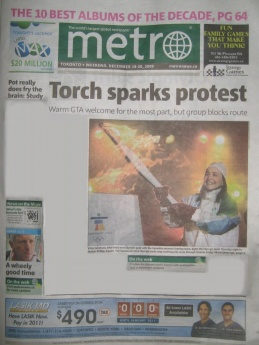It Never Happened
In the Chinese media no one was killed in Tiananmen Square
If you think you saw people being killed on the square on your television sets, it was rumors started by the western media.
Jiang Zemin and Li Peng and umpteen lesser people, including the Xinhua News Agency, and all the Chinese press have been repeating this over and over again, so it must be true. Mustn’t it?
Following what I have just said, this story about a friend of mine puzzles me. I can’t identify her. She was in the Beijing Hotel the night it all began at some function unrelated to what was going on in the square. The function had ended and she was in the lobby when she met Sue Bigelow, a Ryerson graduate who had fled to the hotel for sanctuary, a grenade’s throw from Tiananmen Square. Sue told the woman that she must not go out because they were shooting. The woman said she had to go to be a witness.
She went towards the square. When she got there, the soldiers renewed their firing right into the crowd. Most of the people ran, making themselves targets for the soldiers’ fire. She had enough sense to fall to the ground, the safest place. Soon the crowd had gone but she stayed still on the ground and before long she heard two Chinese voices.
“Look, here is a foreigner.”
“Is she dead?” A boot pushed her in the middle.
“I think so,” said the other voice. “No,” the second voice said, “look,” and she felt a boot touch her arm which had been holding a pole supporting a fence around a hedge. Her arm had been trembling.
Then a boot went into her middle and turned her face up. She opened her eyes and by this time she was surrounded by soldiers all pointing their AK-47s at her. They told her to get up and go. She found she was soaking in blood-other people’s.
She said no.
“Why?” they asked.
She told them she was incapable of getting up. She was too frightened. They lifted her and started prodding her off the square. Then along came an officer, wearing a red cross arm band carrying an AK-47, and he asked the men what was happening. They told him they had found her and were trying to get her off the square. He said, “Why don’t you shoot her?”
The soldiers pushed her into a huton (a narrow lane), prodded her in the back with their guns and told her to go and not look back. Not many steps farther on she heard a row behind her and looked back. She turned and saw a bunch of soldiers who had a man on the ground beating him with the butts of their weapons.
She ran back and told them to stop.
They told her to keep on going. While they were discussing the man being beaten, he managed to get up and flee. Whose blood was she wearing? It wasn’t hers. That’s why it puzzles me when they say no one was killed on the square.
Ever since That Day, as the people of Beijing call it, the Chinese media have been parading a variety of people across television screens and splashing them through the ink of their pages proclaiming that nobody was killed on Tiananmen Square. There was one man who took sanctuary in “a foreign embassy” for 70 days. He came out and held a press conference proclaiming that he was one of the last to leave Tiananmen and he saw nobody killed. Skeptics, like me, felt there was a suggestion of intimidation especially as he had fled to an embassy-thought to have been the Australian. He had done something for which he would be punished. He came out and, instead of the punishment that would seem to have followed, he almost immediately held a press conference and he was free.
But why is it relevant whether they were shot on the square or not? Whether the picture was distorted or not, I, and the world, saw a picture in which there were bodies and hordes of people were killed. I wouldn’t swear that those pictures showed me people being killed on the square. But I saw, as you saw, people being killed. That was the truth.
What does it matter the name of the street?
This is a joint byline for the Ryerson Review of Journalism. All content is produced by students in their final year of the graduate or undergraduate program at the Ryerson School of Journalism.













































